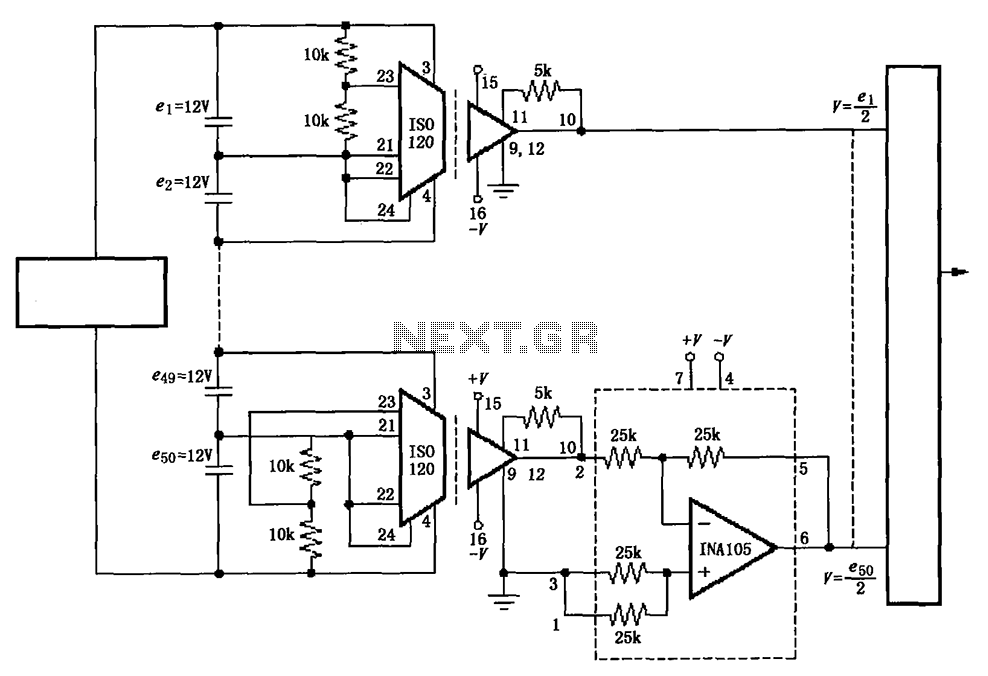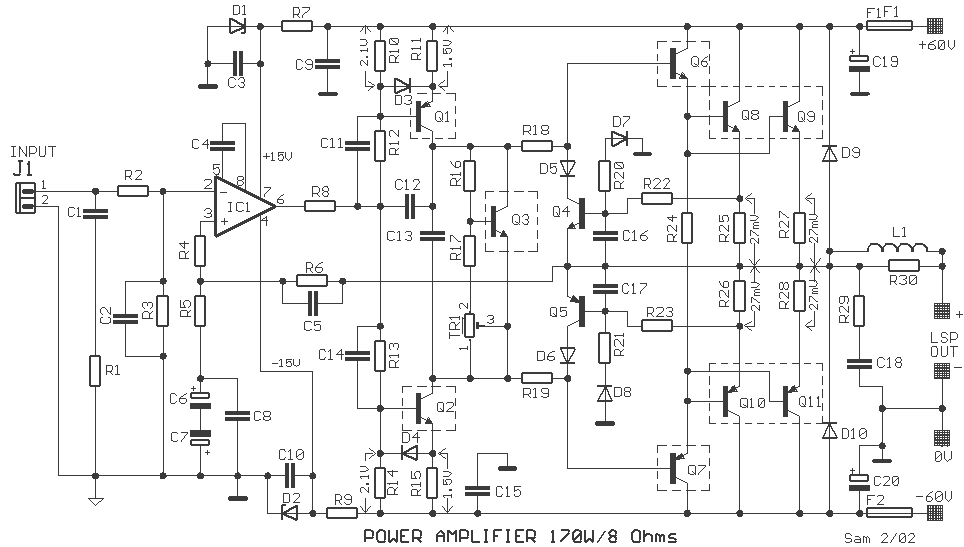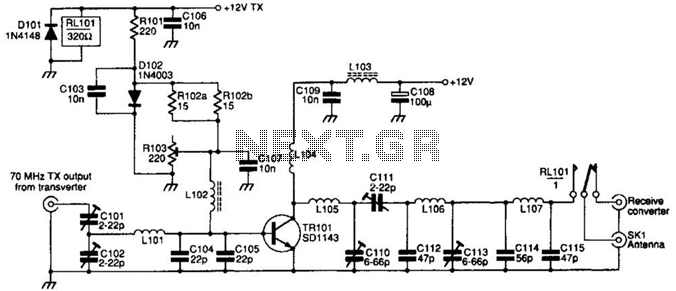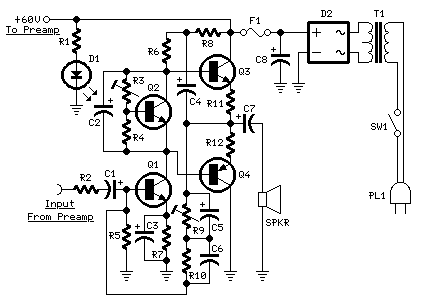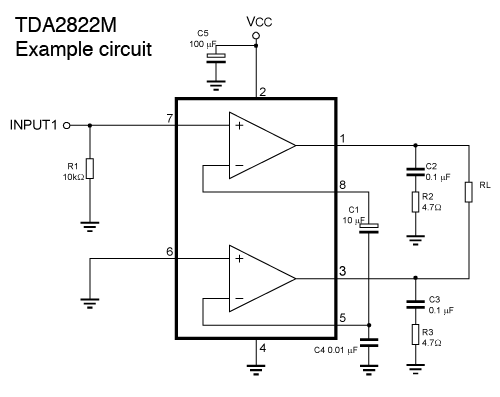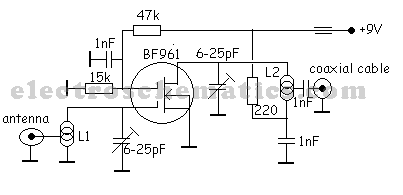
10-W Class A Amplifier
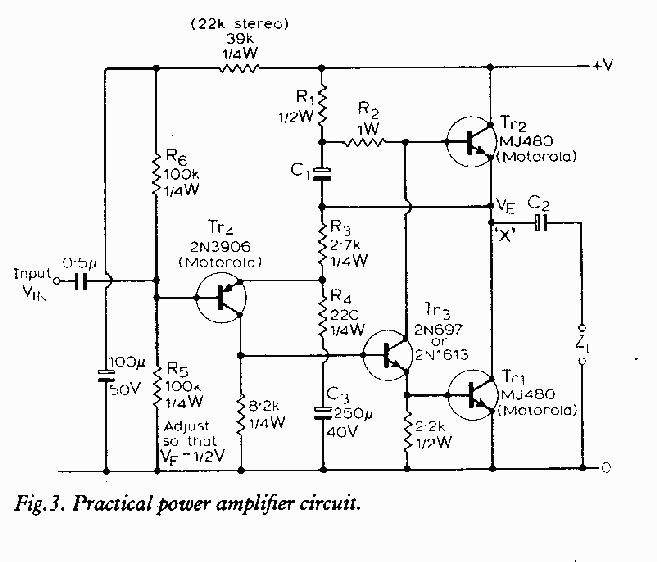
The major advantage of amplifiers of this type is that the normal static power dissipation is very low, and the overall power-conversion efficiency is high. Unfortunately, there are also some inherent disadvantages due to the intrinsic dissimilarity in the response of the two halves of the push-pull pair (if complementary transistors are used in asymmetrical circuit arrangement), together with some cross-over distortion due to the I c /V b characteristics. An additional characteristic of the class B output stage is that the current demand of the output transistors increases with the output signal, and this may reduce the output voltage and worsen the smoothing of the power supply, unless this is well designed.
In the context of amplifier design, particularly Class B amplifiers, the operational characteristics and design considerations are crucial for achieving optimal performance. Class B amplifiers utilize a push-pull configuration, where two complementary transistors (NPN and PNP) amplify the positive and negative halves of the input signal, respectively. This configuration is advantageous due to its high efficiency, as each transistor conducts for only half of the input waveform, minimizing power dissipation during idle conditions.
However, the design must carefully consider the matching of the transistors in the push-pull pair. Dissimilarities in the characteristics of the transistors can lead to crossover distortion, which occurs during the transition between the two conduction states. This distortion is particularly noticeable at low output levels when one transistor turns off and the other turns on. To mitigate this issue, biasing techniques such as class AB operation can be employed, where a small bias current keeps both transistors slightly on, reducing the crossover region and improving linearity.
Another critical aspect of Class B amplifiers is the power supply design. The output current demand from the transistors increases with the output signal, which can lead to voltage drops across the power supply rails if not adequately designed. This situation can worsen the smoothing of the power supply, resulting in ripple and potential degradation of audio performance. To address this, adequate power supply decoupling and regulation must be implemented to ensure stable voltage levels during operation.
In summary, while Class B amplifiers offer significant advantages in terms of efficiency and low static power dissipation, careful attention must be paid to the matching of the output transistors and the design of the power supply to minimize distortion and ensure consistent performance. Proper biasing and power supply design are essential for optimizing the operation of these amplifiers in various applications, including audio amplification and signal processing.The major advantage of amplifiers of this type is that the normal static power dissipation is very low, and the overall power-conversion efficiency is high. Unfortunately there are also some inherent disadvantages due to the intrinsic dissimilarity in the response of the two halves of the push pull pair (if complementary transistors are used in asymmetrical circuit arrangement) together with some cross-over distortion due to the I c /V b characteristics.
An additional characteristic of the class B output stage is that the current demand of the output transistors increases with the output signal, and this may reduce the output voltage and worsen the smoothing of the power supply, unless this is well design 🔗 External reference
In the context of amplifier design, particularly Class B amplifiers, the operational characteristics and design considerations are crucial for achieving optimal performance. Class B amplifiers utilize a push-pull configuration, where two complementary transistors (NPN and PNP) amplify the positive and negative halves of the input signal, respectively. This configuration is advantageous due to its high efficiency, as each transistor conducts for only half of the input waveform, minimizing power dissipation during idle conditions.
However, the design must carefully consider the matching of the transistors in the push-pull pair. Dissimilarities in the characteristics of the transistors can lead to crossover distortion, which occurs during the transition between the two conduction states. This distortion is particularly noticeable at low output levels when one transistor turns off and the other turns on. To mitigate this issue, biasing techniques such as class AB operation can be employed, where a small bias current keeps both transistors slightly on, reducing the crossover region and improving linearity.
Another critical aspect of Class B amplifiers is the power supply design. The output current demand from the transistors increases with the output signal, which can lead to voltage drops across the power supply rails if not adequately designed. This situation can worsen the smoothing of the power supply, resulting in ripple and potential degradation of audio performance. To address this, adequate power supply decoupling and regulation must be implemented to ensure stable voltage levels during operation.
In summary, while Class B amplifiers offer significant advantages in terms of efficiency and low static power dissipation, careful attention must be paid to the matching of the output transistors and the design of the power supply to minimize distortion and ensure consistent performance. Proper biasing and power supply design are essential for optimizing the operation of these amplifiers in various applications, including audio amplification and signal processing.The major advantage of amplifiers of this type is that the normal static power dissipation is very low, and the overall power-conversion efficiency is high. Unfortunately there are also some inherent disadvantages due to the intrinsic dissimilarity in the response of the two halves of the push pull pair (if complementary transistors are used in asymmetrical circuit arrangement) together with some cross-over distortion due to the I c /V b characteristics.
An additional characteristic of the class B output stage is that the current demand of the output transistors increases with the output signal, and this may reduce the output voltage and worsen the smoothing of the power supply, unless this is well design 🔗 External reference
